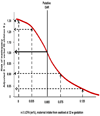Considerations regarding neuropsychiatric nutritional requirements for intakes of omega-3 highly unsaturated fatty acids
- PMID: 19619995
- PMCID: PMC3182570
- DOI: 10.1016/j.plefa.2009.06.005
Considerations regarding neuropsychiatric nutritional requirements for intakes of omega-3 highly unsaturated fatty acids
Abstract
Background: Adverse neurodevelopmental and neuropsychiatric outcomes have been established as signs of nutrient deficiencies and may be applicable to insufficient dietary intakes of omega-3 highly unsaturated fatty acids (n-3 HUFAs).
Objective: Consider if statistical definitions for Daily Reference Intakes can be applied to n-3 HUFAs intakes during pregnancy for maternal and neurodevelopmental deficiencies.
Design: Data were prospectively collected from women during pregnancy and children up to age 8 years participating in the Avon Longitudinal Study of Parents and Children (ALSPAC). Statistical analyses took social and lifestyle factors into account.
Results: During pregnancy, n-3 HUFA intakes from seafood that putatively meet statistical definitions of an estimated average requirement ranged from 0.05 to 0.06 en% (111-139 mg/d/2000 Cal) for suboptimal fine motor control at 42 m and 0.065-0.08 en% (114-181 mg/d/2000 Cal) for suboptimal verbal IQ at age 8 years and 0.18-0.22 en% (389-486 mg/d/2000 Cal) for maternal depression at 32 weeks. Intakes of n-3 ranging from 0.2 to 0.41 en% (445-917 mg/d/2000 Cal) prevented both increased risk of maternal depression and adverse neurodevelopmental outcomes for children among 97.5% of the population. No upper limit for safety was found.
Conclusion: During pregnancy, a n-3 HUFA intake of 0.40 en% (900 mg/d/2000 Cal) from seafood is likely to meet the nutritional requirements for 97.5% of the mothers and children of this population. These considerations do not constitute DRI's for docosahexaenoic acid and n-3 HUFAs, but may contribute to their formulation.
Conflict of interest statement
We declare that we have no conflict of interest.
Figures

References
-
- Hellwig JP, Meyers LD. Dietary reference intakes: the essential guide to nutrient requirements. Washington, D.C: National Academy of Sciences Press; 2006.
-
- Salem N, Jr, Litman B, Kim HY, Gawrisch K. Mechanisms of action of docosahexaenoic acid in the nervous system. Lipids. 2001;36:945–959. - PubMed
-
- Golding J, Pembrey M, Jones R. ALSPAC--the Avon Longitudinal Study of Parents and Children. I. Study methodology. Paediatr Perinat Epidemiol. 2001;15:74–87. - PubMed
-
- ALSPAC Study. http://www.bristol.ac.uk/alspac/last asseessed 23 April 2009.
-
- Hibbeln JR, Davis JM, Steer C, et al. Maternal seafood consumption in pregnancy and neurodevelopmental outcomes in childhood (ALSPAC study): an observational cohort study. Lancet. 2007;369:578–585. - PubMed
Publication types
MeSH terms
Substances
Grants and funding
LinkOut - more resources
Full Text Sources
Medical
Research Materials

